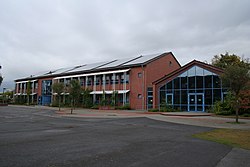Amplonius Gymnasium Rheinberg
| Amplonius Gymnasium Rheinberg | |
|---|---|
| type of school | high school |
| School number | 166029 |
| founding | 1337 |
| address |
Dr.-Aloys-Wittrup-Str. 18th |
| place | Rheinberg |
| country | North Rhine-Westphalia |
| Country | Germany |
| Coordinates | 51 ° 33 '0 " N , 6 ° 35' 36" E |
| carrier | City of Rheinberg |
| student | 933 (October 15, 2020) |
| Teachers | 88 (June 19, 2019) |
| management | Marcus Padtberg |
| Website | www.amplonius.de |
The Amplonius-Gymnasium Rheinberg is a German high school . It is located in Rheinberg on the Lower Rhine in North Rhine-Westphalia .
history
The school's origins go back to 1337. At that time, a Latin school was first mentioned in a chronicle . The principal was a priest named Wiricus.
The scholar Amplonius Ratingk de Berka (1363-1435) set up a foundation to enable students of the Rheinberg Latin School to study at the University of Erfurt , of which he was rector. Thanks to the foundation, these scholarship holders were able to live free of charge in the "Himmelspforte" (Porta Coeli) in Erfurt and study at the university. From these students the rector of the Latin school was chosen by the Rheinberg magistrate , who had to teach in Rheinberg for four years after attaining the first academic title.
In 1366 a clergyman from Orsoy named Buelemann was mentioned as the school principal. From 1388 the Latin school was on the market, near the church. It was destroyed in 1598. A new school building was then erected in Marktstrasse (today's Underbergstrasse). In 1781 there were a total of five schools in Rheinberg, namely a French, two Catholic and a Reformed school in addition to the Latin school. In 1785, a girls' school was finally set up in St. Barbara Garden.
In 1816 the University of Erfurt was abolished and the “Himmelspforte” building was closed. The Amplonian Foundation was therefore converted into capital assets, but the Latin School continued to exist. In 1873, during the so-called Kulturkampf in Prussia, the school was placed under a secular school principal, after all headmasters had previously been clergy. In 1889 the Latin school finally closed its doors.
In 1903 a private rectorate school was re-established. Lessons began with eight students at van Elsbergen's house on Kamper Strasse. The first headmaster was Dr. Aloys Wittrup , who held the office until 1939. In 1905 the Catholic parish on Goldstrasse built a new building for the rectorate school. In 1912 the city took over the school while preserving its Catholic character. In 1920/21 the rectorate school had 121 students. A first attempt to raise the school to a Progymnasium failed due to the city's lack of money.
All home students attended the municipal rectorate school, which is why the building on Goldstrasse became too small. This was followed by a move to Konvikt St. Josef on Lützenhofstrasse, which was built in 1929/30 by the Pallottine Congregation, a spiritual community. In 1939 the school was elevated to a high school for boys. The school was temporarily closed towards the end of the war.
Dr. After teaching resumed in October 1945, Cäcilie Tolksdorf was in charge of official affairs, but was replaced by a man two years later. In 1946 the municipal high school became a Progymnasium, which was attended by 356 students in 1950. In 1951 the first new building was inaugurated; at the same time the school was given its current name.
In 1956 the second phase of the Amplonius grammar school was completed. In 1957 it was raised to a fully developed high school. It was only from this point in time that the school was able to complete the Abitur . This option was first used in 1960 by 19 high school graduates.
In 1961, the construction of the third construction phase began, the gym with a teaching pool, which is now used as an event hall ("cult pool"). In 1970 the Pallottine Fathers left Rheinberg after 40 years and the Konvikt was closed. In 1978 the Amplonius-Gymnasium had almost 1,100 students.
The school partnership initiated in 1982 with the Lycée and the Collège in the northern French city of Montreuil became a city partnership in 1993 .
In June 1998 the last construction phase was handed over with the natural science wing.
In 2010, the Amplonius-Gymnasium was energetically renovated as part of the economic stimulus package II ; In particular, the installation of new windows and the complete renovation of the gym should be emphasized.
Leitmotif
The following inscription from 1614 was found in the entrance bar of the first Latin school in Rheinberg on the market :
- INSTRUE PRAECEPTIS ANIMUM NEC DISCERE CESSES
NAM SINE DOCTRINA VITA EST QUASI MORTIS IMAGO
- "Form your mind through teaching and never stop learning,
because without education life is like an image of death."
Well-known graduates
- Ernst Kausen , computer scientist, mathematician and linguist
- Claudia Schiffer , photo model
- Josef van Genabith , linguist and university professor
- Isabell Werth , dressage rider, lawyer and Olympic champion
- Jürgen W. Möllemann , politician (FDP)
- Marcus Uhlig , former managing director of Arminia Bielefeld
literature
- Wittrup, Aloys: The school history of the city of Rheinberg. Michael Schiffer, Rheinberg undated
Web links
Individual evidence
- ↑ Further information. In: www.schulministerium.nrw.de. Retrieved June 19, 2020 .
- ↑ teacher. In: www.amplonius.de. Retrieved June 19, 2020 .
- ↑ Extended school management. In: www.amplonius.de. Retrieved June 19, 2020 .
